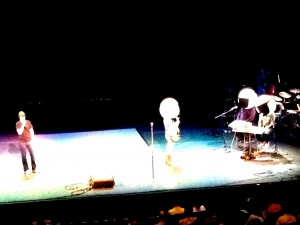A radio show is something you listen to, maybe through headphones or in the car, with voices — not visuals — to guide the way.
And a magazine is something you hold in your hands, flipping through stories, looking at pictures, sometimes tearing out a page to save for later.
That is, until it's not.
In the past week, I've attended two genre-bending live events that play on our assumptions about the functions of different forms. At
RadioLab Live in Berkeley, hosts Jad Abumrad and Robert Krulwich brought an episode of the
science-focused public radio show to the stage with visuals ranging from screen projections to live dancing to flickering lights in the audience. And at
Pop-Up Magazine, authors, artists, and photographers presented their work on stage — with nothing recorded, handed out, or written down except for the "table of contents."

Each event had familiar elements. In the case of RadioLab Live, the performance followed the general structure of the radio show — various acts, or stories, broken up by brief musical interludes — and the sound came from a mix of on-stage narration and pre-recorded interviews. At Pop-Up Magazine, authors and artists delivered their pieces in an order familiar to magazine readers: short, pithy articles (gadget reviews, travel dispatches) followed by longer features on foreign affairs, culture, and crime. But both were also completely different experiences — not a radio show, or a magazine, or a theater performance, but something borrowing elements from all of those formats and twisting them into something new. They're shapeshifters, morphing from one form into another.
These days, our world is filled with shapeshifting experiences. Take stores: If you ask me to picture a clothing store, I still imagine a physical place that I visit to buy things. But there are online shops, and mobile shops, and hybrids like physical stores with online-ordering kiosks. Imagine what it must have been like to imagine an online store for the first time. What parts of a physical store would need to carry over so people could tell what was going on? And what could the online version offer to still be different and worthwhile?
I'm not sure if there are universal guidelines that explain how shapeshifters can get the most out of each of their different experiences. But if I learned one thing from Pop-Up Magazine and RadioLab Live, it's this: I like when each new format is recognizable as a relative of the original but still new and novel enough to be offering something I could only get in that particular way.
What shapeshifting experiences have you encountered?